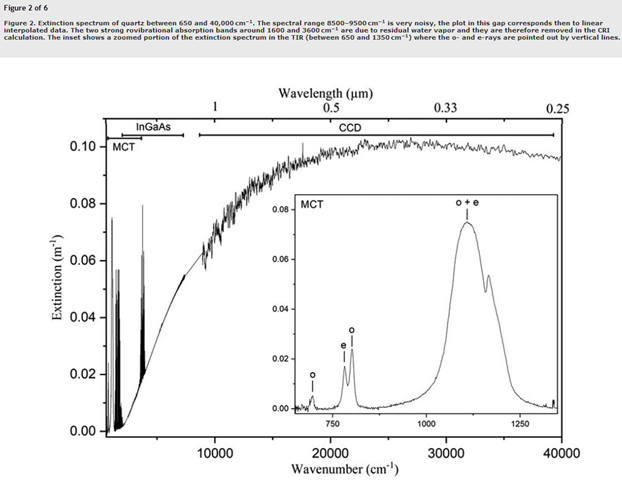By Sarah Petters, Aarhus University
Finding the color of sand: Thermal infrared, shape factor, and extraordinary rays
“Complex refractive index of crystalline quartz particles from UV to thermal infrared”
Hervé Herbin, Lise Deschutter, Alexandre Deguine, and Denis Petitprez, Univ. Lille, CNRS, Lille, France
Read the full article:
Herbin, H., Deschutter, L., Deguine, A., and Petitprez, D. (2023). Complex refractive index of crystalline quartz particles from UV to thermal infrared. Aerosol Science and Technology 57 (3):255–265. https://doi.org/10.1080/02786826.2023.2165899.
You’ve seen it in museum shops and in sand boxes. It keeps the time in your watch. Silicon dioxide (quartz) is ubiquitous on Earth and forms a dominant part of other rocky planets in the solar system. As mineral dust, SiO2 plays an important role in the redistribution of radiation in the atmosphere.
But what color is it, really? The optical properties of the bulk material are different from those of the aerosolized powder. Radiative transfer depends on the size distribution, refractive index of the material (real and imaginary parts), and radiation wavelength. This calculation is especially hard for crystalline SiO2.
Recently, Herbin and co-authors at the University of Lille (France) measured the extinction and size spectra of aerosol quartz in a closure study aimed at correcting the refractive index for quartz aerosols in a spectral range useful for remote sensing (Herbin et al., 2023). They started their extinction measurement in the thermal infrared (TIR, 650–1350 cm-1, 7–15 µm wavelength) and scanned all the way to short-wave UV (40,000 cm-1, 250 nm). In the TIR region (inset of Figure 2) you can see with clarity the separation of rays in the birefringent material (o-, e-, and o+e absorption peaks, particularly near 800 cm-1). You will have to read the article to see what is extraordinary about the ‘e’ peak.
Particle number-size distributions were measured with a scanning mobility particle sizer and an aerodynamic particle sizer, revealing a significant but expected non-spherical shape (a χ value of about 1.33) – the mode diameter was about 200 nm. The irregular particle shape is revealed as an important factor in infrared remote sensing of dust.
The authors close the gap between the model of the extinction spectrum – formulated using Mie theory – and the measured extinction spectrum. Mie theory has generally performed well for non-spherical particles, except in the TIR region of the spectrum. The non-spherical and birefringent properties of quartz introduce spectral features here that were not well captured by prior models. A non-spherical adjustment (namely, the continuous distribution of ellipsoids (CDE) model) performed very well for the spectral features observed in the TIR – and also performed well to reproduce an extinction spectrum measured using the same setup for a distinct SiO2 sample.

This Issue’s Newsletter Committee:
Editor | Krystal Pollitt, Yale UniversitySenior Assistant Editor | Justice Archer, University of BristolJunior Assistant Editor | Dong Gao, Yale UniversityGuest Contributor | Sarah Petters, Aarhus University